七年级下册英语知识点总结
人教版七年级英语下册各知识点归纳总结
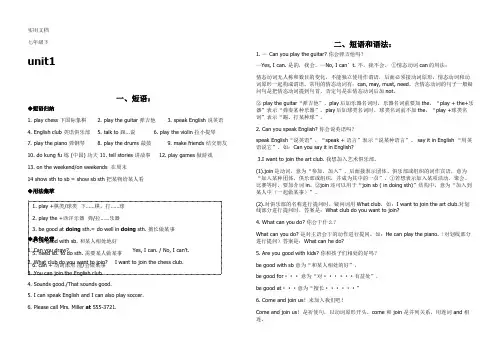
七年级下unit1一、短语:◆短语归纳1. play chess 下国际象棋2. play the guitar 弹吉他3. speak English 说英语4. English club 英语俱乐部5. talk to 跟…说6. play the violin 拉小提琴7. play the piano 弹钢琴8. play the drums 敲鼓9. make friends 结交朋友10. do kung fu 练 (中国) 功夫 11. tell stories 讲故事 12. play games 做游戏13. on the weekend/on weekends 在周末14 show sth to sb = show sb sth 把某物给某人看◆用法集萃◆典句必背1. Can you draw? Yes, I can. / No, I can’t.2. What club do you want to join? I want to join the chess club.3. You can join the English club.4. Sounds good./That sounds good.5. I can speak English and I can also play soccer.6. Please call Mrs. Miller at 555-3721.二、短语和语法:1. — Can you play the guitar? 你会弹吉他吗?—Yes, I can. 是的,我会。
—No, I can’t. 不,我不会。
①情态动词can的用法:情态动词无人称和数目的变化,不能独立使用作谓语,后面必须接动词原形,情态动词和动词原形一起构成谓语。
常用的情态动词有:can, may, must, need。
含情态动词的句子一般疑问句是把情态动词提到句首,否定句是在情态动词后加not。
七年级下册英语必背知识点
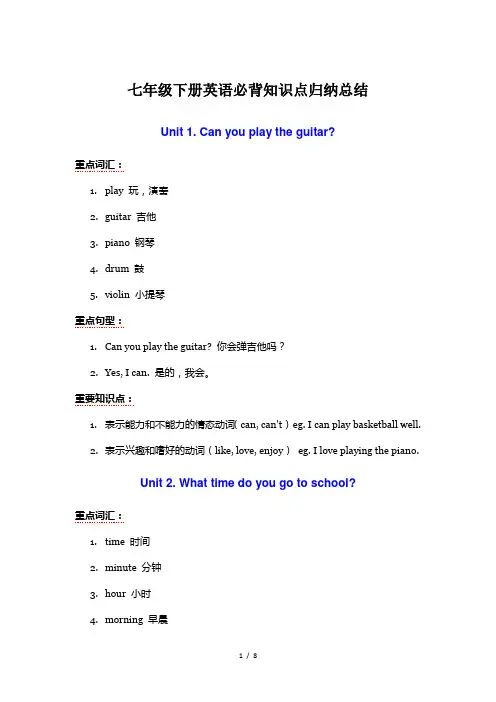
七年级下册英语必背知识点归纳总结Unit 1. Can you play the guitar?重点词汇:1.play 玩,演奏2.guitar 吉他3.piano 钢琴4.drum 鼓5.violin 小提琴重点句型:1.Can you play the guitar? 你会弹吉他吗?2.Yes, I can. 是的,我会。
重要知识点:1.表示能力和不能力的情态动词(can, can't)eg. I can play basketball well.2.表示兴趣和嗜好的动词(like, love, enjoy)eg. I love playing the piano.Unit 2. What time do you go to school?重点词汇:1.time 时间2.minute 分钟3.hour 小时4.morning 早晨5.afternoon 下午6.evening 晚上重点句型:1.What time do you get up? 你几点起床?2.I usually go to school at 7:30. 我通常七点半去上学。
重要知识点:1.表示时间的问答方式和用法eg. What time is it now? It's half past eight.2.表示日常生活习惯的一般现在时eg. I usually do my homework afterschool.Unit 3. How do you get to school?重点词汇:1.bike 自行车2.walk 步行3.bus 公交车4.subway 地铁5.taxi 出租车重点句型:1.How do you get to school? 你怎么去上学?2.I usually take the bus. 我通常坐公交车。
重要知识点:1.表示交通工具的名词和用法eg. I ride a bike to school every day.2.表示方式的副词和表达方式eg. He walks to work every morning.Unit 4. Don’t eat in class.重点词汇:1.don't do sth. 不要做某事2.eat 吃3.drink 喝4.talk 谈话5.listen 听6.music 音乐重点句型:1.Don't talk in class. 上课时不要讲话。
七年级下册英语语法知识点归纳总结
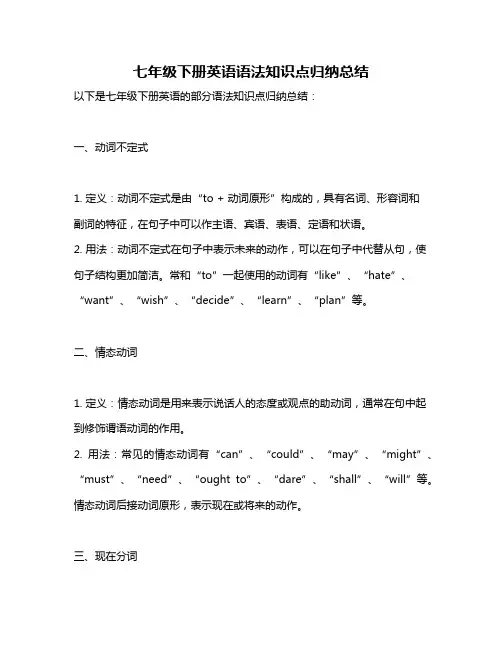
七年级下册英语语法知识点归纳总结以下是七年级下册英语的部分语法知识点归纳总结:一、动词不定式1. 定义:动词不定式是由“to + 动词原形”构成的,具有名词、形容词和副词的特征,在句子中可以作主语、宾语、表语、定语和状语。
2. 用法:动词不定式在句子中表示未来的动作,可以在句子中代替从句,使句子结构更加简洁。
常和“to”一起使用的动词有“like”、“hate”、“want”、“wish”、“decide”、“learn”、“plan”等。
二、情态动词1. 定义:情态动词是用来表示说话人的态度或观点的助动词,通常在句中起到修饰谓语动词的作用。
2. 用法:常见的情态动词有“can”、“could”、“may”、“might”、“must”、“need”、“ought to”、“dare”、“shall”、“will”等。
情态动词后接动词原形,表示现在或将来的动作。
三、现在分词1. 定义:现在分词是动词的一种形式,具有形容词的特征,可以表示正在进行的动作或状态。
2. 用法:现在分词可以作定语、表语和状语。
常和“-ing”一起使用的动词有“seeing”、“feeling”、“thinking”、“doing”、“being”等。
四、介词短语1. 定义:介词短语是由介词和名词或代词构成的短语,用来表示时间、地点、方式等。
2. 用法:介词短语在句子中可以作状语、定语和表语。
常见的介词有“in”、“on”、“at”、“for”、“with”、“by”等。
五、连词1. 定义:连词是用来连接两个句子或从句的词语,表示它们之间的关系。
2. 用法:常见的连词有“and”、“but”、“or”、“so”、“because”、“if”等。
连词在句子中起到承上启下的作用,使句子的意思更加清晰。
以上是七年级下册英语的部分语法知识点归纳总结,希望对你有所帮助。
七年级下册英语知识点归纳总结
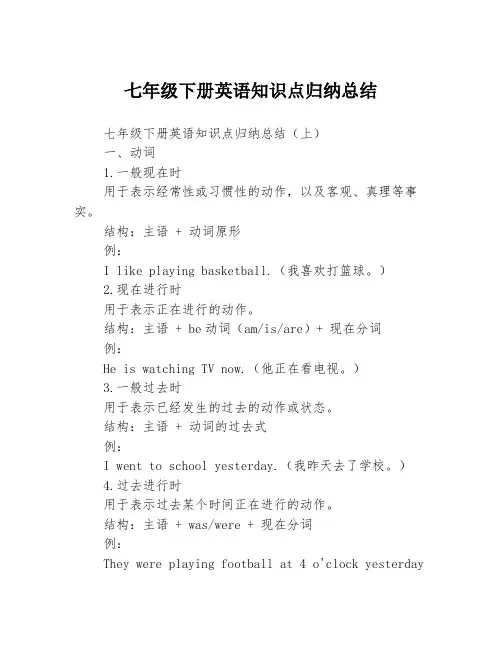
七年级下册英语知识点归纳总结七年级下册英语知识点归纳总结(上)一、动词1.一般现在时用于表示经常性或习惯性的动作,以及客观、真理等事实。
结构:主语 + 动词原形例:I like playing basketball.(我喜欢打篮球。
)2.现在进行时用于表示正在进行的动作。
结构:主语 + be动词(am/is/are)+ 现在分词例:He is watching TV now.(他正在看电视。
)3.一般过去时用于表示已经发生的过去的动作或状态。
结构:主语 + 动词的过去式例:I went to school yesterday.(我昨天去了学校。
)4.过去进行时用于表示过去某个时间正在进行的动作。
结构:主语 + was/were + 现在分词例:They were playing football at 4 o'clock yesterdayafternoon.(他们昨天下午4点正在踢足球。
)5.将来时用于表示将来某个时间要发生的事情。
结构:主语 + will/shall + 动词原形例:We will have a picnic next Saturday.(我们下周六去野餐。
)二、数词1.基数词表示数量的数字,如:one(1)、two(2)、three(3)等。
2.序数词表示顺序的数字,如:first(第一)、second(第二)、third(第三)等。
3.小数表示不是整数的数。
如:0.5、1.25等。
4.百分数表示百分比的数,如:50%、80%等。
三、名词1.可数名词表示能够用数目进行计算的名词,如:book(书)、student(学生)等。
2.不可数名词表示无法用数目进行计算的名词,如:water(水)、milk(牛奶)等。
3.复数名词表示“多个”的名词。
规则:在词尾加-s。
如:books(书)、students(学生)等。
四、形容词用于修饰名词或代词。
1.形容词的比较级用于表示两者之间的比较。
七年级英语下册单元知识点总结
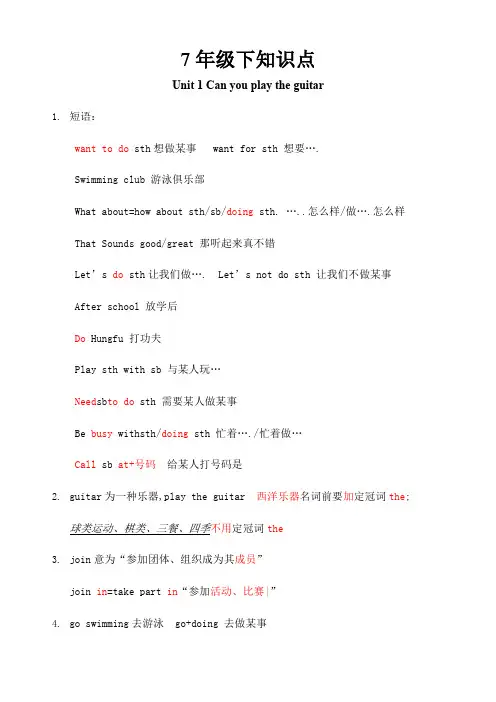
7年级下知识点Unit 1 Can you play the guitar1.短语:want to do sth想做某事 want for sth 想要….Swimming club 游泳俱乐部What about=how about sth/sb/doing sth. …..怎么样/做….怎么样 That Sounds good/great 那听起来真不错Let’s do sth让我们做…. Let’s not do sth 让我们不做某事After school 放学后Do Hungfu 打功夫Play sth with sb 与某人玩…Need sb to do sth 需要某人做某事Be busy withsth/doing sth 忙着…./忙着做…Call sb at+号码给某人打号码是2.guitar为一种乐器,play the guitar 西洋乐器名词前要加定冠词the;球类运动、棋类、三餐、四季不用定冠词the3.join意为“参加团体、组织成为其成员”join in=take part in“参加活动、比赛|”4.go swimming去游泳go+doing 去做某事5.注意区分:speak, say, talk和tella)①say说话 What can you sayb)②speak+语言c)③talk表示两个人或多个人在一起讲话、谈论多指随意谈论talk with sb与某人交谈 talk to sb 向某人说… talk about谈论…;d)④tell的意思是“告诉,讲述,吩咐”,讲故事或讲笑话多用tell;6.Show “表演,演出,出示……给某人看”, show sth. to sb.=show sb. sth.;7.show作名词,意为“展览,展出”on show “在展出” car show 车展;school show 学校公演fashion show 时装表演;a flower show花展8.help sth. 在……方面帮助某人help sth.帮助某人….. help sth.帮助某人干什么;a)I often help him do his homework.b)I often help him his homework.9.be good with... 与……相处得好;与……合得来=get on well withbe good at doing sth擅长做某事 be good for对……有益处;be good to sb 对某人好10.Can you play the guitar你能弹吉他吗情态动词:不能单独做谓语动词;无人称、单复数变化;后接动词原形1.表示能力能;会;如:He can speak English.他会说英语;2.表示许可,意为“可以”,这时可以和may通用,但是比may较正式;如:Can I use your pen我可以用你的钢笔吗3.表示可能性,意为“可能”,这时常出现在否定句中;如:It can’t be true.这不可能是真的;4.表示提供帮助;如:Can you help me你可以帮助我吗1.肯定句:主语+can+动词原形+其他;如:2.否定句:主语+can’t+动词原形+其他;如:3.一般疑问句:Can+主语+动词原形+其他肯定答语:Yes,主语+can.否定答语:No,主语+can’t.如:4.特殊疑问句:疑问词+can+主语+动词原形+其他如:What can I do for you我能为你做点什么呢Unit 2 What time do you go to school1.重点短语:get up 起床 get dressed 穿衣服 get on上车 get off 下车get home到达家中get to work到达工作岗位practice guitar 练吉它 practice doing sth练习做…leave home 离家take a shower = have a shower 洗淋浴澡have/eat breakfast/dinner/lunch 吃早、晚、午饭go to bed 睡觉反义词get upput on 穿衣服反义词take offdo one’s homework 做家庭作业tell sb. about sth. 告诉某人某事love to do = like to do 喜欢干某事 like doing sth at around/about six o’clock 六点左右in the morning/afternoon/evening 在早上/下午/晚上listen to 听…on weekends=at the weekend 在周末on school days 在学校上课日late for… …. 迟到了lots of =a lot of 许多a good /bad habit 好习惯take a walk=have a walk 散步live a happy life 过着幸福的生活2英语时间的表达What is the time 几点了It’s….1直接法:6:10 →six-ten 8:50→eight-fifty6:00 →six o’clocko’clock可省2借助介词to/past分钟数+to/past+小时小于等于30分钟“past” 超过10:15→ a quarter past ten或fifteen past ten 9:30→half past nine或thirty past nine大于30分钟“to”差….到….翻译时要注意时钟要加111:50→ten to twelve9:45→a quarter to ten或fifteen to ten3 what time与when的区别what time “几点”问的是具体的时间,回答要具体到小时;What time do you go to school你什么时候/几点上学when提问,回答既可以是具体的时间,也可以是不具体的时间,如:in the morning,last year,in 1998等范围大的时间;例如:When does he take a shower他什么时候洗澡He takes a shower in the morning.他在早上洗澡;也可用具体时间:I take a shower at 6 o’clock in the morning.我早上六点洗澡;3、 listen to, hear和sound△listen to意为“注意听”,表示有意识地去听,但不一定听得见什么,强调听的动作;They are listening to the teacher. 他们在听老师说;△hear意为“听见”,强调听的结果;如:I’m sorry to hear that.听到那个消息我很难过;△sound意为“听起来,听上去”,可作系动词+形容词The music sounds sweet. 这音乐听起来悦耳;Unit 3 How do you get to school1、重点短语搭配take the subway 乘地铁every day 每天think of 认为 think about 考虑between…and….在…和…之间 next to在旁边come true 实现I think so 我也这样认为I don’t think so 我不这样认为It’s easy /difficult for sb to do sth 对某人而言做什么是很容易/困难的it is easy to get to school到达学校很容易on a ropeway 坐缆索cross the river 穿过河流one 11-year-old boy 一个11岁的男孩红色部分为一个形容词I’m 11years old 我11岁quickly 动作上快 fast 速度上快 soon时间上快the river runs quickly 河水流的快ten minutes’ walk / a ten-minute walk =10 minutes on foot 10分钟的路be afraid to do/ be afraid of sth / doing害怕做某事why not +v原形 == why don’t you +v原形为什么不...........how to do it 怎么来做它what to do 做什么what do you think of =how do you like你觉得怎么样how long does it take sb to do sth花费某人多长时间做某事crossing the river is… 穿过河是…ing型动词做主语谓语动词用单数2、How do you get to school你怎样到达学校交通方式的表达:1 take/ride/drive + a/the +交通工具take a bus/car…2by +交通工具 by bus/car3on/in + a/the +交通工具in:封闭/半封闭/小型工具;on:大型4ride/fly/drive to +交通工具= go to +地点+by+交通工具walk to+地点= go to+地点on foot.eg: I drive to school every day.= I go to school by carI walk to school every day.= I go to school on foot3、spend, cost, pay 与 take区别(1)spendsb spend…on sth或spend…in doing sth.意为“某人花时间/金钱做某事”;eg: I spent 5 dollars on the book.=I spend 5 dollars buying the book.(2)coststh cost sb some money意为“某物花费某人多少钱”;eg: The skirt costs her 200 yuan.(3)paysb pay money for sth.意为“某人为某物付款”;eg: He paid 1000 yuan for the TV set.(4)takeIt takes sb time/ money to do sth.eg: It took him seven days to make the big cake.4、Then the early bus takes him to school.take…to…意为“把…带去…” bring….to….把…带来….5、how far用来提问距离,意为“多远;How far is it from A to B=How far is B from A A 到B有多远①用长度单位表示eg: —— How far is it from your home to the bus stop ——It’s five kilometers.②用时间表示eg: —— How far is the park from the shop——It’s ten minutes’ walk.6、how long 用来提问时间,意为“多久”;eg: —— How long have you been in America—— For two years. for+短时间表示“长达…”7、say, speak, talk与tell8、look, read, see与watch9、there be 句型就近原则There is no bridge=there is not a bride 这儿没有桥◆unit 4 Don’t eat in class.1、重点短语与句型on time准时 in time 及时fight for 为….而斗 fight against 为反对….而战斗 fight with 与…一起战斗go outsider 去外面It’s important for sb to do sth 对…人而言做…是很重要的practice sth/ doing sth 练习…/练习做…do the dishes 清洗餐具make bed 铺床be strict with sb 对某人严格remember/forget to do sth 记得/忘记要做…remember/forget doing sth 记得/忘记做过…follow the rules 遵守规则learn from sb/sth 从…..学习 learn to do sth 学会做某事be late for school 上学迟到have to 不得不don’t have to=needn’t 不必 must 的一般疑问句否定回答school uniform 校服on school nighs 在上学日的晚上too much+不可数名词“太多” too many +可数名词的复数“太多”much too + 形容词/副词“太….”in the kitchen 在厨房let/make/have sb do sth 让某人做某事good luck 好运keep+形容词保持… keep quiet 保持安静=be quietkeepsb doing sth 一直做某事 He keeps me waiting for him a long time. 他让我等了他很久keep sb from doing sth 阻止某人做某事have fun doing sth 很高兴做某事。
初一下册英语知识点总结归纳
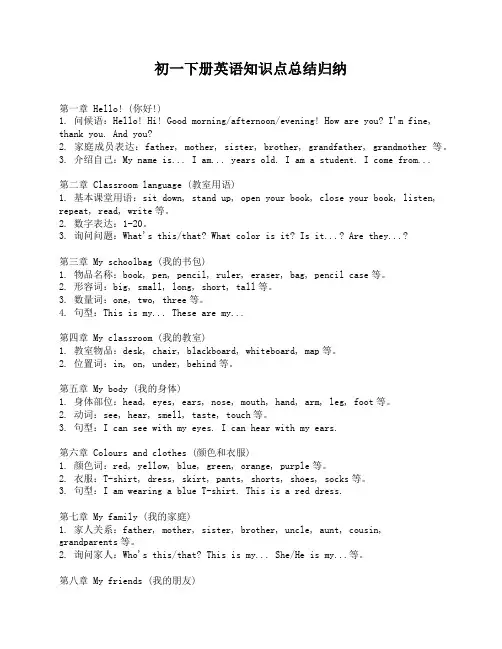
初一下册英语知识点总结归纳第一章 Hello! (你好!)1. 问候语:Hello! Hi! Good morning/afternoon/evening! How are you? I'm fine, thank you. And you?2. 家庭成员表达:father, mother, sister, brother, grandfather, grandmother等。
3. 介绍自己:My name is... I am... years old. I am a student. I come from...第二章 Classroom language (教室用语)1. 基本课堂用语:sit down, stand up, open your book, close your book, listen, repeat, read, write等。
2. 数字表达:1-20。
3. 询问问题:What's this/that? What color is it? Is it...? Are they...?第三章 My schoolbag (我的书包)1. 物品名称:book, pen, pencil, ruler, eraser, bag, pencil case等。
2. 形容词:big, small, long, short, tall等。
3. 数量词:one, two, three等。
4. 句型:This is my... These are my...第四章 My classroom (我的教室)1. 教室物品:desk, chair, blackboard, whiteboard, map等。
2. 位置词:in, on, under, behind等。
第五章 My body (我的身体)1. 身体部位:head, eyes, ears, nose, mouth, hand, arm, leg, foot等。
七年级下册1到6单元英语知识点
七年级下册1到6单元英语知识点
以下是七年级下册英语1到6单元的一些主要知识点:
1. Unit 1: Personal Information
-介绍自己的基本信息,如姓名、年龄、国籍等。
-问与回答关于个人信息的问题。
-学习使用形容词来描述自己和他人。
2. Unit 2: School Life
-学习和使用关于学校生活的词汇,如科目、课程表、校园设施等。
-学习描述日常活动和时间表。
-学习使用一般现在时来表达习惯和常规。
3. Unit 3: Hobbies and Interests
-学习和使用关于爱好和兴趣的词汇,如运动、音乐、艺术等。
-学习表达自己的喜好和不喜欢。
-学习使用动词的-ing形式来描述正在进行的活动。
4. Unit 4: Daily Routines
-学习和使用关于日常生活的词汇,如起床、吃早餐、上学等。
-学习描述日常活动的顺序和时间。
-学习使用一般现在时来描述日常例行事务。
5. Unit 5: Food and Health
-学习和使用关于食物和健康的词汇,如水果、蔬菜、饮食习惯等。
-学习表达食物的喜好和不喜欢。
-学习使用情态动词can和should来表达能力和建议。
6. Unit 6: Travel and Transportation
-学习和使用关于旅行和交通的词汇,如旅游景点、交通工具等。
-学习描述旅行计划和行程。
-学习使用一般将来时来表达将来的计划和打算。
七年级下册英语知识点归纳总结
七年级下册英语知识点归纳总结一、词汇与短语1. 学校科目:Math, Science, History, Geography, English, Chinese, Art, Music, PE (Physical Education)2. 学校设施:Library, Canteen, Gym, Playground, Computer lab, Auditorium3. 常见动词:Play, Sing, Dance, Draw, Read, Write, Listen, Speak, Think4. 常见形容词:Big, Small, Happy, Sad, Tall, Short, Young, Old, Beautiful, Ugly5. 日常活动:Get up, Brush teeth, Take a shower, Eat breakfast, Go to school, Have classes, Do homework, Watch TV, Go to bed6. 常见名词:Book, Pen, Pencil, Eraser, Notebook, Teacher, Student, Parent, Friend7. 常见介词:In, On, Under, Behind, Between, Next to, Across from, Above, Below8. 常见副词:Quickly, Slowly, Carefully, Loudly, Quietly, Well, Badly, Often, Never二、语法要点1. 时态- 一般现在时:表示经常发生的动作或状态,如:I usually play soccer on weekends.- 一般过去时:表示过去某一时间发生的动作或状态,如:He visited his grandparents last weekend.- 一般将来时:表示将来某一时间将要发生的动作,如:Theywill go on a trip next month.2. 代词- 人称代词主格:I, You, He, She, It, We, They- 物主代词:My, Your, His, Her, Its, Our, Their- 反身代词:Myself, Yourself, Himself, Herself, Itself, Ourselves, Themselves3. 冠词- 不定冠词:A, An (用于单数可数名词前)- 定冠词:The (用于特指的人或物前)4. 介词短语- 表示时间:At + 时间点 (at 8:00), On + 具体日期 (on Monday)- 表示地点:In + 大地方 (in the library), At + 小地方 (at the bus stop)5. 简单句和并列句- 简单句:只有一个主谓结构的句子,如:The dog barks.- 并列句:用并列连词连接的两个或多个简单句,如:She is smart and she works hard.6. 情态动词- Can, Could: 表示能力或许可,如:Can you help me? Could you open the window?- May, Might: 表示可能性,如:It might rain later.- Must, Have to: 表示必须,如:You must do your homework. We have to go now.三、阅读理解技巧1. 快速浏览(Skimming):快速阅读文章,抓住主旨大意。
七年级下册英语全部语法知识点
七年级下册英语全部语法知识点七年级下册英语的全部语法知识点如下:1.一般现在时:表示经常性的或普遍性的动作或状态。
2.一般过去时:表示过去发生的动作或状态。
3.一般将来时:表示将来发生的动作或状态。
4.现在进行时:表示现在进行或暂时的动作。
5.过去进行时:表示过去某个时间正在进行的动作。
6.一般将来进行时:表示将来某个时间进行的动作。
7.现在完成时:表示过去某个时间开始的动作一直持续到现在或刚刚结束。
8.过去完成时:表示过去某个时间之前已经发生的动作。
9.一般将来完成时:表示将来某个时间之前已经完成的动作。
10.疑问句的构成:使用助动词或be动词提问。
11.否定句的构成:在动词前加not或在助动词后加not。
12.肯定句的构成:直接陈述句子的内容。
13.比较级和最高级:用于比较两个或更多事物的形容词和副词。
14.表示数量的词汇:例如:all, most, some, any, few, a few, many, much等。
15.可数名词和不可数名词的用法。
16.单复数形式的变化规则。
17.形容词的用法和位置:用于修饰名词的词汇。
18.物主代词的用法:例如:mine, yours, his, hers, ours, theirs等。
19.反身代词的用法:例如:myself, yourself, himself, herself, ourselves, themselves等。
20.动词不定式的用法:用于表示目的、意图、结果等。
21.情态动词的用法:例如:can, could, may, might, must等。
22.介词的用法:表示位置、时间、原因、目的等。
23.祈使句的用法:用于发出命令、请求等。
24.从句的引导词和用法:例如:because, if, when, where, who等。
25.定语从句和状语从句的用法。
26.非谓语动词的用法:包括动词不定式、动名词和现在分词。
以上就是七年级下册英语的全部语法知识点。
七年级下册英语知识点归纳完整版人教版
七年级下册英语知识点归纳完整版随着学习的深入,七年级下册的英语知识点变得更加复杂和丰富。
为了能够更好地掌握这些知识点,我们需要对其进行归纳总结,从而更好地理解和掌握。
本文将对七年级下册英语知识点进行完整归纳,希望对大家的学习有所帮助。
一、单词和词组1. 表示时间的单词和词组- 表示时间的单词:morning, afternoon, evening, night, hour, minute, second- 表示星期的单词:Monday, Tuesday, Wednesday, Thursday, Friday, Saturday, Sunday- 表示月份的单词:January, February, March, April, May, June, July, August, September, October, November, December- 表示年份的词组:in 2000, in the year of 2022- 表示节假日的单词:New Year's Day, Christmas, Thanksgiving2. 表示地点的单词和词组- 表示地点的单词:home, school, park, library, supermarket, hospital, restaurant- 表示方向的单词:east, west, south, north, right, left- 表示位置的单词:in front of, behind, next to, between, on, under3. 表示人物的单词和词组- 表示家庭成员的单词:father, mother, brother, sister, grandfather, grandmother, uncle, aunt, cousin- 表示职业的单词:teacher, doctor, nurse, policeman, driver, farmer, musician, artist, cook4. 表示动作的单词和词组- 表示日常活动的单词:get up, have breakfast, go to school, have lunch, do homework, watch TV, go to bed- 表示交通工具的单词:car, bus, bike, subway, tr本人n, plane, boat, taxi, walk二、语法1. 一般现在时- 主语 + 动词原形(第三人称单数形式要加 -s)- 一般现在时的用法- 一般现在时的否定句和疑问句2. be 动词- be 动词的形式和用法- be 动词的否定句和疑问句- 特殊疑问句的构成3. 一般过去时- 主语 + 动词过去式- 一般过去时的用法- 一般过去时的否定句和疑问句4. 情态动词- can, could, may, might, must, shall, should, will, would, ought to 的用法- 情态动词的否定句和疑问句5. 形容词和副词- 形容词的比较级和最高级- 副词的用法6. 数词和冠词- 基数词和序数词- 不定冠词 a/an- 定冠词 the7. 代词- 人称代词、物主代词、反身代词的用法- 不定代词的用法8. 名词- 可数名词和不可数名词- 名词的单数和复数形式- 名词所有格的构成三、句型和短语1. 询问个人信息的句型- What's your name?- How old are you?- Where are you from?- Which grade are you in?2. 表示喜欢和讨厌的句型- I like swimming.- She doesn't like dancing.- Do you like playing basketball?- What does he like?3. 表示能力和可能性的句型- I can play the guitar.- She may be at home.- Could you help me, please?- He might note tomorrow.4. 表示经历和时间的句型- I have been to Beijing.- She has lived here for three years. - Have you ever seen a koala?- How long have you studied English?5. 表示建议和请求的句型- You should wash your hands.- Can you help me, please?- Let's go shopping.- Would you like some tea?四、阅读和写作1. 阅读理解- 根据文章内容回答问题- 根据上下文推测词义- 根据图片内容进行阅读理解2. 写作- 书面表达- 句子应用- 写作技巧以上是七年级下册英语的知识点的归纳完整版。
- 1、下载文档前请自行甄别文档内容的完整性,平台不提供额外的编辑、内容补充、找答案等附加服务。
- 2、"仅部分预览"的文档,不可在线预览部分如存在完整性等问题,可反馈申请退款(可完整预览的文档不适用该条件!)。
- 3、如文档侵犯您的权益,请联系客服反馈,我们会尽快为您处理(人工客服工作时间:9:00-18:30)。
onGreenstreet 在格林街上near,在,附近gostraight 一直走 welcometo,欢迎havefun 玩得开心thewayto ,去... 的路letsbdosth 让某人做某事takeataxi 打的/ 乘出租车 godown (along ), 沿着... 走 gothrough... 穿过..haveagoodtrip旅途愉快arriveat (小地方)/in (大地方)到达 at thebeginning of 在... 开始的时候 at theendof在...结束的时候 hopetodosth/that/forsth二、日常交际用语。
1、 Isthereabanknearhere?Yes,there is.It ' sonCentreStreet./No,thereisn' t.UnitIWhere ' syourpenpalfrom? 一、词组来befrom=comeform 自...pen pal=pe nfriend 笔友 likeanddislike 好恶;爱憎 livein+ 地点在...居住speak+语言讲某种语言 playsports 做体育运动 alittleFre nch 一些法语 gotothemovies去看电影writetosb 给某人写信anactionmovie 一部动作片on新课标七年级总复习资料weekends 在周末 tellsbaboutsth达告诉某人某事Excuseme 对不起,打扰getto 到达、抵1、 Where+be 主语+ from?主语+ be+from+地点. 主语+2、 W heredo/does+ 主语+ live? live/lives in,3、 W hatla nguagedo/does+ 主语 +speak? 主语+ speak/speaks,.4、 主语+ like/likes+doi ng/todo,5、 Whatisyourfavoritesubject/sport? Myfavoritesubject/sportis6、 It ' sfun.7. Isthatyournewpenpal?Yes,itis. Unit2Where ' sthepostoffice亠、词组 postoffic 在..e由E 局 payphone 投币式公用电话 nextto 在..infrontof . 前面 between,and, 在...禾口...in the neighborhood 在附近 on theright/left.隔壁 acrossfrom 在... 对面之间 onastreet在街上在右边/在左边behind,在,后面 enjoy+名词/doing 喜欢做某事havefun 过得愉快play+the+ onone' sright/lef t 在某人的右边/左边turnright/lef t 乐器弹奏乐器 向右/左转takeawalk2、W here sthe supermarket? It ' snexttothelibrary.3、B ridgeStreetisagoodplacetohavefun.4、I hopeyouhaveagoodtrip.5、I fyouarehungry,youcanbuyfoodintherestaurant.6、T alkawalkthoughthepark..7.lkno wyouarearriv ingn extS un day. 我知道你下周日要来。
三、句型。
1、Istherea ,.?句型Eg:-Excuseme.Isthereahotelintheneighborhood.- Yes,thereis.No.thereisn ' t 2、Whereis, ?句型Eg:-Whereisthepark,please?- It ' sbehindthebank.(肯定回答)-1 ' msorryIdon ' tknow. (否定回答)地点?句型.例如:-Whichisthewaytothelibrary. 地点?句型.例如:-Howcanlgettotherestaurant? wayto + 地点?句型.例-Canyoutellmethewaytothepostoffice?3、 Whichisthewayto+4、 Howcanlgetto+5、 Canyoutell methe6、Letmetellyouthewaytomyhouse. 7Un it3Whydoyoulikekoalas? 一、词组 wanttodosth. 想要做某事 wantsbtodosth、Justgostraightandturnleft.想要某人做某事wantsth 想要某物Letsbdosth让某人做某事kindof 有几分种类akindof ,yearsold, 年龄 liketodosth 喜欢做某事 likedoingsthplaywith , 与... 一起玩 duringtheday 在白天 atnight havealookat..看...on e,theother一个... 另一个...二、句型与日常交际用语。
1、 -whydoyoulikepandas?/-Whydosehelikekoalas? -2、Whydoyouwanttoseethelions?Becausethey ' re3、 -Wherearelionsfrom?-LionsarefromSouthAfrica.4、 -What(other)animalsdoyoulike?-llikeelephants.other+名词的复数.表示没有特定的数量范围 theother+ 名词的复数表示有特定的数量范围. 5. -Doyoulikegiraffes?Yes,ldo./No,ldon' tUn it4Iwa nttobea nactor.一、 词组wanttobe+a/an+ 职业想要成为,shopassistant起工作 helpsb(to)dosth/sbwithsth workhard 努力工作 workfor 为。
而工作 givesth.to.sb/give.sb.sth 把某物给某人 与,讲话goouttodinners 外出吃饭 inahospitalmovieactor 电影演员 二、 句型1.-Whatdo/does+ 某人 +do?例-Whatdoyoudo?- teacher.店员 bankclerk 辛艮行职员 workwith 与,-帮助某人做某事as,作为, workas 作为。
而工作 get..from, 从..获得, in theday 在白天 atnight 在夜间 talk to/with 在医院newspaperreporter报社记者I ' mastudent./-Whatdosehedo?He ' sa2-Whatdo/does+ 某人 +wanttobe?例: Whatdoyouwanttobe?-lwanttobeateacher. 3.-Wheredoesyoursisterwork?-Sheworks in ahospital. 4. -Doeshework in thehospital? Yes,hedoes/No, 5. -Doessheworklate?-Yes,shedoes/No, 6. 一英语中询问职业的几种表达方式: hedoes n 't shedoesn 't Whatdo/does,do?/Whatis,?Whatisyourfather Unit5l ' mwatchingTV. 一、词组 sjob?/ What sone ' sjob? doone' shomework 做家庭作业 watchTV 看电视 eatdinner 吃饭;就餐 cleantheroom 打 扫房间talkonthephone 电话聊天sound+形容词听起来,thanksfor+ n/doing 为某事感谢 某人goshopping/swimming 去购物/游泳atthepool 在游泳池 takephotos 拍照TVshow 电视节目Someof,中的一些 atschool 在学校 bewith 禾口。
一起 inthetree 张/最后一张照片withsb 和某人在一起 二、句型与日常交际用语 aphotoofmyfamily 在树上 打篮球/踢足球 我的家庭照 在第一 一种,在夜间Becausethey ' reverycure.1.-What+be+ 主语+do正在做什么?-主语+ bedoing。
,正在做某事ing?3.-Hereare/is,1. -Doyouwa nttogotothemovies?2. -Whe ndoyouwa nttogo?3. -Wheredopeopleplaybasketball? 4. -What ' shewaitingfor? 5. -What ' shereading?He 6. Youca nseemyfamilyathome. 四、语法:现在进行时 1) 现在在进行时的形式是:助动词 be(am,is,are)+ 发生的动作。
2) 现在进行时的肯定句形式3) 现在进行时的否定句形式 Theyare no tplay in gsoccer. 例:Herearesomeofmyphotos.Hereisaphotoofmyfamily.-Sure.-Let ' sgoatseven.-Atschool. -He ' swaitingforabus. 'sreadinganewspaper. Can+do(动词原形)可以,动词-ing 形式(也叫现在分词),表示现在(说话的瞬间)正在进行或 主语+be(am,is,are)+动词现在分词+其他I ' mwatchingTV.主语+be(am,is,are)+not+ 动词现在分词+其他4) 现在进行时的一般疑问句形式及回答Is(am,are)+主语+动词现在分词+其他?Yes,主语 +is/am/are.No, 主语 +isn ' t/arennot. 5) 现在进行时的特殊疑问句形式:特殊疑问词+is/am/are+主语+现在分词+其他?Unit6lt ' sraning!一、 词组Playcomputergames 打电子游戏 in picture 度假 Takephotos agroupofpeople 人或某人感到惊讶 t/am not. Are youread in g?Yes,I例:Whatisyourbrotherdoing?am.No,I am在图片里AroundTheWorld 世界各地Onvacation 拍照Onthebeach 在海边lieonthebeach 躺在沙滩上 一群人 playbeachvolleyball 打沙滩排球 besurprisedatsth./sb. 对某 inthisheat 在酷暑中berelaxed 放松haveagoodtime 玩得很痛快在不同的天气里Thanksbfor(doing)sth由于某事而感谢某人 in differe ntkin dofweatherHow sitgoing?look+adj 看起来」。
